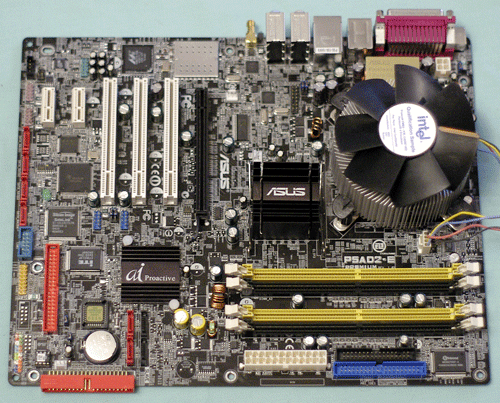FIRST LOOK: Asus P5AD2-E - 1066FSB & DDR2-711
by Wesley Fink on November 29, 2004 12:01 AM EST- Posted in
- Motherboards
Basic Features
The P5AD2 has one of the most complete selections of BIOS adjustments and board features that you will find on a Socket 775 motherboard. Therefore, Asus had no real need to include additional features on the P5AD2-E. The changes that were made are generally enhancements to existing options, like extending the chipset voltages and memory voltages and providing finer adjustments.| Asus P5AD2 Premium Motherboard Specifications | |
| CPU Interface | Socket 775 Pentium 4 (Prescott) |
| Chipset | Intel 925XE/ICH6R |
| FSB Speeds | 1066, 800 |
| Clock Speeds | 100MHz to 400MHz (in 1MHz increments) |
| PCI Speeds | To CPU, 33.33, Auto |
| DDR2 Speeds | Auto, 400, 533, 711 |
| Core Voltage | 1.4375V to 1.6125V in 0.0125V increments |
| DRAM Voltage | 1.80V to 2.20V in 0.05V increments |
| Chipset Voltage | Auto, 1.5V to 1.8V in 0.05V increments |
| FSB Termination Voltage | Auto, 1.2 to 1.5V in 0.05V increments |
| Memory Slots | Four 240-pin DDR2 Slots Dual-Channel Unbuffered Memory to 4GB |
| Expansion Slots | 1 PCIe x16 Slot 2 PCIe x1 slot 3 PCI Slots |
| Onboard SATA/IDE RAID | 4 SATA 150 drives by ICH6R Can be combined in RAID 0, 1, Intel Matrix PLUS 4 SATA 150 RAID by Sil3114R RAID 0, 1, 10, 5 |
| Onboard IDE | One Standard ATA100/66 by ICH6R (2 100/66/33 drives) Plus One IDE RAID by ITE 8212F (2 133/100/66, RAID 0, 1, JBOD) |
| Onboard USB 2.0/IEEE-1394 | 8 USB 2.0 ports 3 IEEE 1394b FireWire Ports by TI 1394b |
| Onboard LAN | 2 X Gigabit PCIe LAN Both by Marvel 88E8053 |
| Onboard Audio | CMedia CMI9880 (Intel HD) 8-Channel with SPDIF in/out |
| Wireless LAN | WiFi 802.11g Included |
| Tested BIOS | 1005 Beta 002 |
The one surprise in the Asus update to the P5AD2-E is the reduced range of CPU voltages. The original P5AD2 provides a vCore range from 1.4375V to 1.7875V, where the new -E version is just 1.4375V to 1.6125V. That's an adequate range, but it seems the wrong way to be going for top-line options. We hope that Asus will correct this in a BIOS update.

The Asus 925XE/925X boards are Premium boards - clearly top-of-the-line in every way. All of the Asus Proactive AI (Artificial Intelligence) features are included. This includes a special cooling plate on the bottom of the board in the CPU area that Asus calls Stack Cool.

Features are all but identical to the P5AD2, with both LAN ports powered by the new Marvel 88E8053 Ethernet controllers on the faster PCI Express bus. The P5AD2-E includes a complete WiFi setup with embedded (built into the board) 802.11g capabilities and an external antenna. You will also find 3 of the high-speed "b" versions of IEEE 1394 firewire, which promise double the speed of 1394a ports. Speed-step, a new Intel feature that allows the CPU to be downclocked to 14 for FSB/memory overclocking or cooler operation, is another Asus feature.
The premium C-Media CMI9880 codec supports the Intel High-Definition audio, with 8 channels and Dolby Digital Live technology support. The CMI9880 is the only audio solution we've seen that has a built-in Dolby AC3 encoder. The encoder can actually encode your digital audio into Dolby digital streams, which can be output to the SPDIF for Dolby Digital playback. The CMI9880 does this real-time for any digital audio in your system to feed Dolby Digital playback. Asus carries High-Definition (Azalia) audio further on the P5AD2-E and the P5AD2 than any other 925XE/925X board that we have seen.
The storage area is one area where the Asus stands above the crowd. All of the 925X/925XE boards support the ICH6R standard 4 SATA/1 IDE (2drives) configuration. The P5AD2/-E boards add 4 more SATA ports for a total of 8 SATA ports. They go even further by adding an ITE controller for 2 more IDE devices for a total of 4. Asus even includes a slot-mounted external SATA adapter for converting 2 SATA ports into external SATA ports for handling external SATA devices.
Asus is a manufacturer who pays close attention to the layout of their motherboards. We praised the layout of the P5AD2, and the P5AD2-E is exactly the same layout. Floppy and Hard Drive connectors are in the preferred upper right board-edge position, where they usually work best in most case designs. The 24-pin power connector and 4-pin 12V connector are both at board edges where they do not require being snaked across the CPU and restricting air flow. The 8 SATA ports are clustered at the lower right of the board (4 ports) and the bottom edge of the board (4 ports). The additional IDE connector is also near the bottom edge along with the headers for additional SATA and IEEE1384b ports.










34 Comments
View All Comments
ceefka - Monday, November 29, 2004 - link
oh yeah and of course EE, 1-2MB caches.ceefka - Monday, November 29, 2004 - link
#12 Makes you wonder why Asus would go through their trouble ;-) The 1394b is nice of course, but not with a CPU like that. If a boost in FSB isn't doing it for Intel, then what will?#8 I have been wondering about Intel's answer to AMD64 since it came out. There's no (real) answer still, but we've seen Prescott, 1066 FSB, DDR2, BTX and 3.8GHz. They're missing a key element to improve performance and it's not been in the above.
jimmy43 - Monday, November 29, 2004 - link
This is depressing...I honestly dont see the point of any of these intel reviews, its like their purpose is to remind us occasionaly about that other company that makes cpus, what was their name? OH RIGHT! IntelAikouka - Monday, November 29, 2004 - link
It's nice to see ASUS whomp on the sell-out and his fancy little board ;). But I think the Gigabyte NF4 board Anandtech showed a little bit ago may either win or tie in features. The Gigabyte board does lack an awesome sound codec, though.Maybe nVidia will be the saving grace of Intel like it was for AMD back in the nForce 2 days. We certainly know VIA wasn't helping to raise performance by a lot :P.
j@cko - Monday, November 29, 2004 - link
Obviously, Intel didn't learn from it's previous lessons..j@cko - Monday, November 29, 2004 - link
Moving to new standard is a rather old trick from Intel. If you look back at Pentium III with PC1333 in which involved VIA's PC133 and INtel's RAMBUS...Now, Intel is doing it again... While cannot beat AMD with its DDR, they move on to DDR II...
overclockingoodness - Monday, November 29, 2004 - link
It is being speculated that dual-core from Intel and AMD will bring them closer in performance, but until then Intel is in deep waters. Seriously, what was the world's largest chip maker thinking by moving to newer standards so suddenly?While Intel is facing some serious loses right now, I have a feeling that Intel may get the last laugh in a couple years when it is back in lead. By that time, all these technologies will mature and slowly start to spread out in the market. AMD is moving to PCIe soon so that's good news, but what about DDR2?
Ah well, it's a constant debate that will never settle. :)
Bozo Galora - Monday, November 29, 2004 - link
Intel has checkmated itself.They have no options - except dual core.
robbase29a - Monday, November 29, 2004 - link
So Mr. Fink, did you say that you can put an intel 560 in this and it would still work, and probably work better than in a 925x motherboard? I would like to see those numbers along with some overclocking numbers too.bob661 - Monday, November 29, 2004 - link
Oh, one more thing. Let the flaming begin!!!!!